
I had to check my diary to remind myself when the last protest outside the Ministry of Justice (MOJ) had taken place. It was then I had last seen the ‘No Men in Women’s Prisons’ banner that I’d originally made for the Downview protest back in 2019.
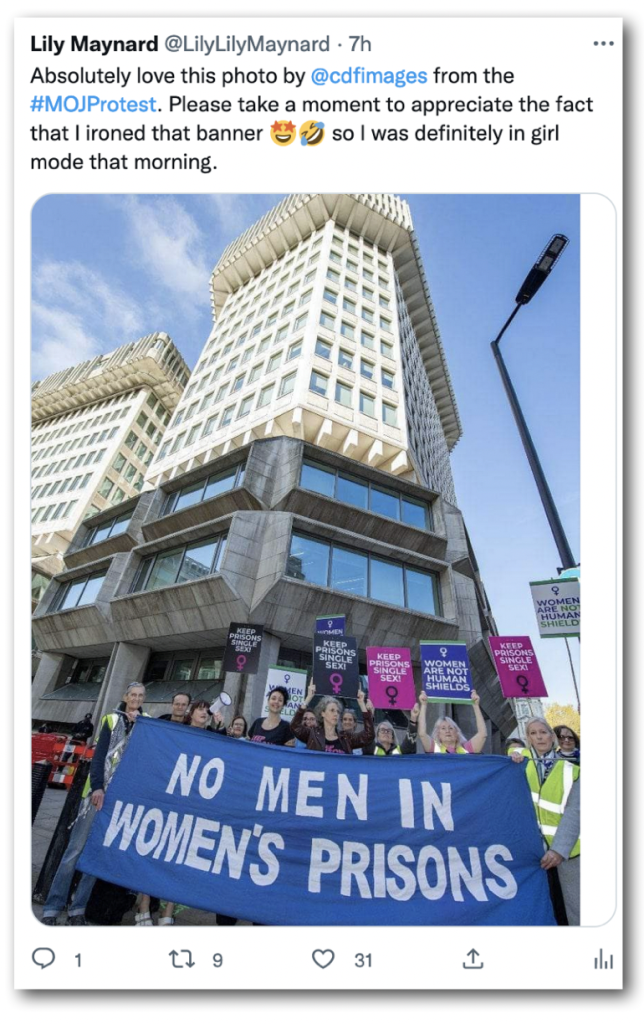 My diary revealed that it took place in February earlier this year. It seemed more recent, I reflected, as I pulled things off shelves and out of cupboards, trying to remember where the hell I’d put the banner. I found quite a few things I didn’t know I’d lost- including a giant inflatable snowman and half a box of Hot Tamales– but by 2am I still hadn’t found it.
My diary revealed that it took place in February earlier this year. It seemed more recent, I reflected, as I pulled things off shelves and out of cupboards, trying to remember where the hell I’d put the banner. I found quite a few things I didn’t know I’d lost- including a giant inflatable snowman and half a box of Hot Tamales– but by 2am I still hadn’t found it.
“I’ll sleep on it,” I thought, absent-mindedly devouring the slightly sticky Tamales, and lo and behold the magic worked and I found it within ten minutes the next morning. In one of the first places I’d looked for it. Obviously.
The banner was really creased, having crouched squashed under a pile of canvas for several months. A creased banner doesn’t photograph well, and I knew that not only would we be taking photos ourselves but press photographer Colin from CDF Images was coming down from Glasgow.
I sighed. I knew what had to be done. Luckily I was able to take a deep breath, establish myself firmly in girl mode and break out the iron. As you can see here in Colin’s photo, the banner ended up looking great.
Thank goodness for girl mode.
MOJ 12/11/22
The protest was arranged by Keep Prisons Single Sex, for Saturday 12th November 2022 and we were meeting outside the MOJ at 12.30pm for speeches, chanting and songs. Four speakers were lined up:
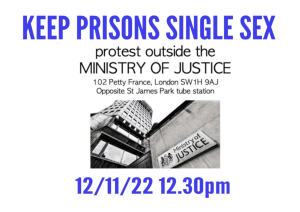
Kate Coleman, founder and Director of Keep Prisons Single Sex
Richard Garside, Director of the Centre for Crime and Justice Studies
Rebekah Wershbale, Ex-prisoner and women’s rights campaigner
Joan Smith, writer and human rights activist, former chair of the Writers in Prison committee
Meeting at the Ministry
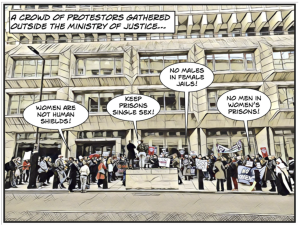
The crowd at the February protest
In February this year, at the original protest outside the MOJ, around 180 people turned up. About a third of that number gathered outside the Ministry of Justice at 12.30 on 12th November.
Sadly DJ Lippy and Aja were unable to come along, likewise a few other familiar faces had gone down with Covid or other seasonal ills. Others had transport issues and fewer people came from out of town. At the last protests, a few groups of women had come on train or by coach from Scotland and Manchester. This time most of those attending were London based, with the exception of the amazing Jen Critical, who had travelled down from the windswept North.
Some of us arrived early, bringing banners and placards and flasks of coffee, the stewards sporting yellow HiViz jackets with KPSS printed on the back.
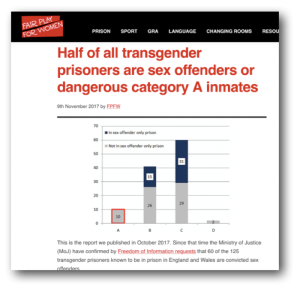 Winter still hasn’t really arrived in London, it felt like an early autumn day, crisp and sternly sunny. As I queued for a quick coffee in the Costa outside St James Park Station I reflected on some of the more infamous men to be placed in the female estate.
Winter still hasn’t really arrived in London, it felt like an early autumn day, crisp and sternly sunny. As I queued for a quick coffee in the Costa outside St James Park Station I reflected on some of the more infamous men to be placed in the female estate.
We’re just going to have a look at two of them here: David Thompson (convicted 2018) and John Steven Dixon (convicted 2022) – aka Karen White and Sally Ann Dixon.
David Thompson aka Karen White
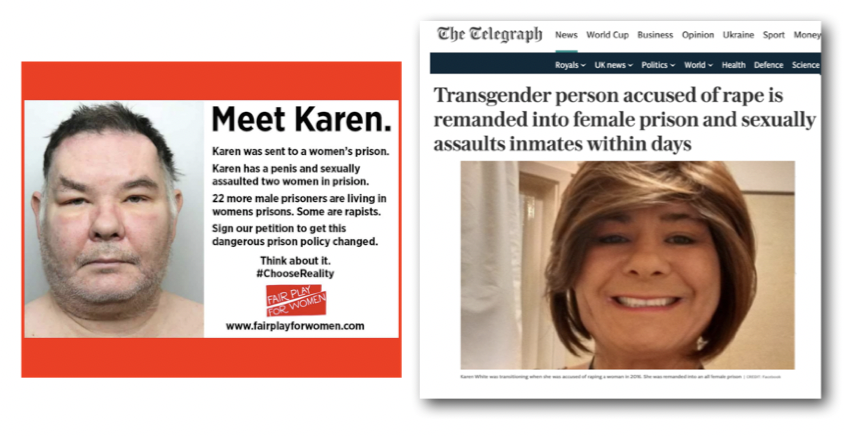 The original case that pushed the issue into the public eye was that of ‘Karen White’.
The original case that pushed the issue into the public eye was that of ‘Karen White’.
In 2018 rapist and paedophile David Thompson aka Karen White, (a man with a penis) was convicted of sexually assaulting two inmates while on remand at HMP New Hall, a women’s prison. For the few who remain unaware of this case, you can read more about it here.
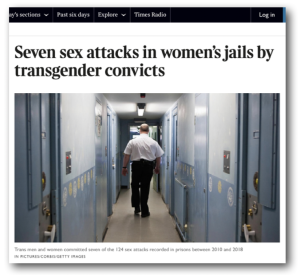 The incident was not isolated: reports suggest that almost half the trans-identified men in prison have convictions for sex offences. In 2020 it was revelaed that at least seven attacks had taken place within the female estate.
The incident was not isolated: reports suggest that almost half the trans-identified men in prison have convictions for sex offences. In 2020 it was revelaed that at least seven attacks had taken place within the female estate.
Those were the ones that were reported.
In January 2022, a woman who had been sexually assaulted by White on several occassions, spoke to the Daily Mail about her experience and the incident was once again brought to public attention.
White told Cheryle Kempton he was hiding his hormone medication in order to recover his sex drive. He assaulted her on several occassions. In difference incidents, he asked her to perform a sex act, groped her breast, rubbed himself up against her, and grabbed her hand and put it on his crotch. Cheryle also told the Mail that White had tried to ‘force himself’ on another inmate but luckily another prisoner had walked in and managed to pull White off.
“All her (sic) conversations were about sex. I felt vulnerable and uncomfortable in her (sic) presence.” reported Kempton. “And we all felt like that, even the toughest of us.”
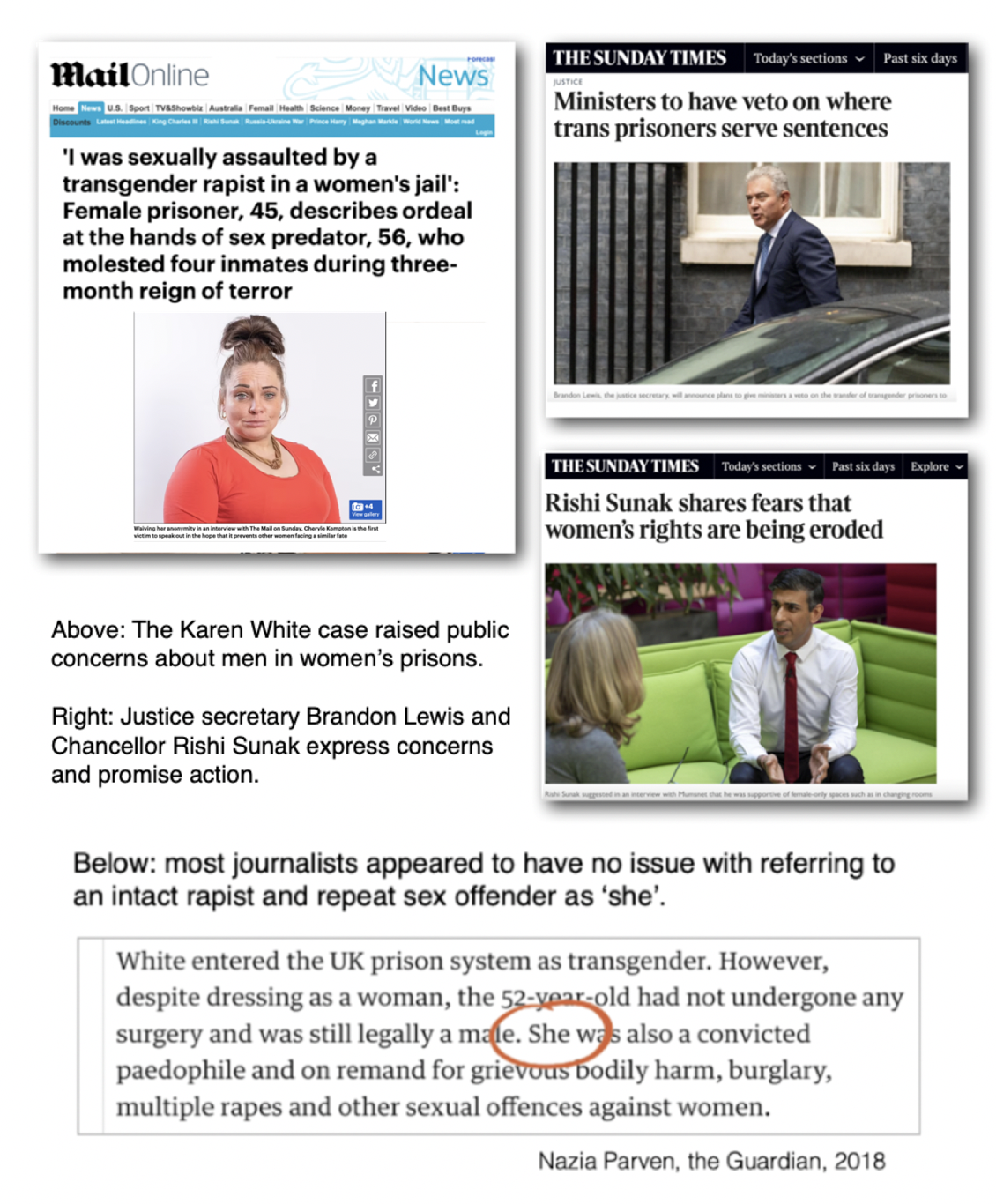
When the case was made public, government ministers rushed to assure women that changes would be made and this would not be allowed to happen in future.
So have things changed since a paedophile and serial rapist was enabled to sexually assault women while incarcerated in a women’s prison? I asked Kate Coleman of KPSS.
“After Karen White, they made it harder for non-GRC holders to get into the female estate and the policy put in place meant that initial allocation for non-GRC holders would be to the male estate.” explained Kate.
“However this year’s allocation of Sally Ann Dixon to the female estate shows that the policy can still permit a man convicted of prolific and serious child sexual offences to be held in a women’s prison, even without a GRC.”
John Stephen ‘Sally Ann’ Dixon
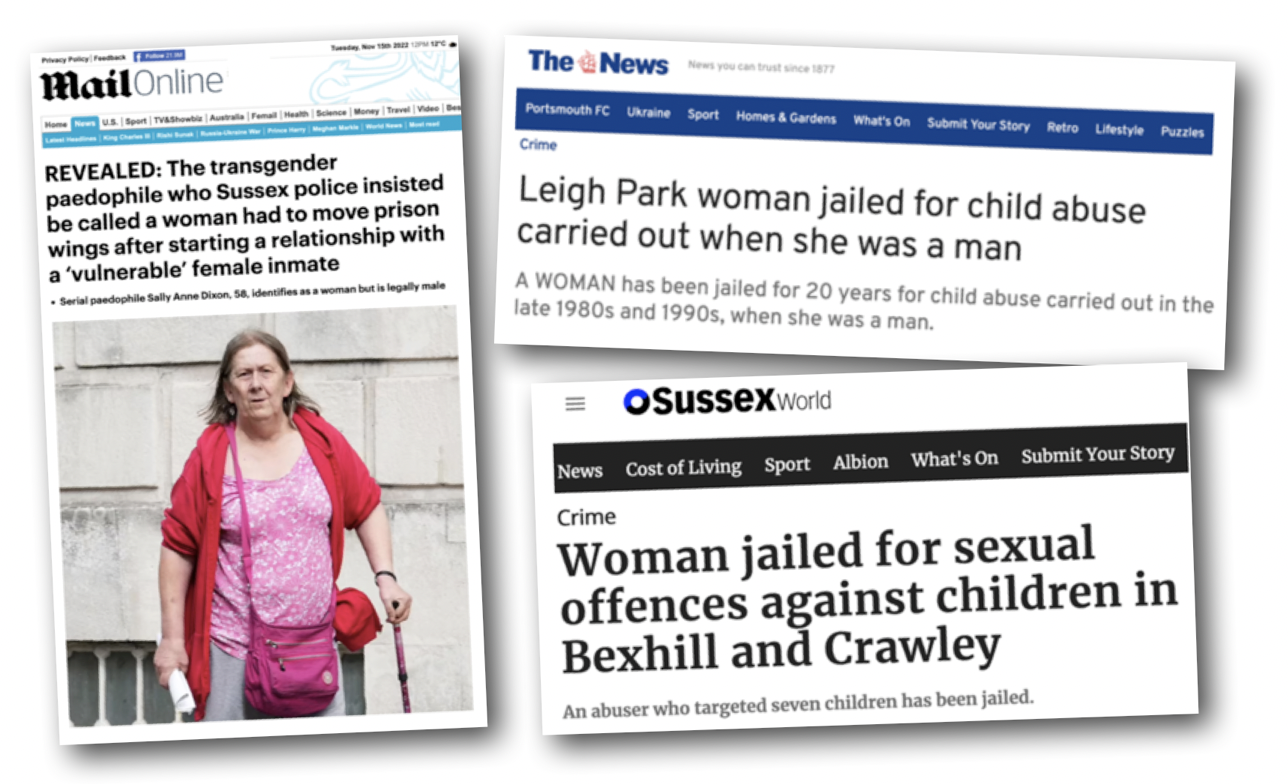
One might think, after the Karen White case, that ministers would be careful to ensure women in their care were kept safe but posh boys like Sunak and Lewis can be slow learners too, and it appears they have learned nothing from past mistakes.
 Twice-married (to women) John Stephen Dixon was born in 1963 and began identifying as a woman in 2004. In September 2022 he was convicted of 30 sexual offences against seven children, committed between 1989-96, and he was sent to prison for twenty years. Throughout the trial, the prosecutor “referred to Dixon by the male pronoun when alluding to the sex offences — without any objection from the defence.”
Twice-married (to women) John Stephen Dixon was born in 1963 and began identifying as a woman in 2004. In September 2022 he was convicted of 30 sexual offences against seven children, committed between 1989-96, and he was sent to prison for twenty years. Throughout the trial, the prosecutor “referred to Dixon by the male pronoun when alluding to the sex offences — without any objection from the defence.”
“However, when Dixon was found guilty, she (sic) was sentenced as a woman and sent to a female prison.” reported the Daily Mail.
This was despite 58 year old Dixon neither being a woman nor having a Gender Recognition Certificate. Within weeks it was reported that he had been moved to a different wing after starting a sexual relationship with a vulnerable young woman who has learning difficulties. It seems that no lessons have been learned from the Karen White case. Visual and vocal protests against the placement of men- whether violent sexual predators or not- in women’s prisons are needed more than ever.
Reporting on the case was confusing to say the least. The Portsmouth News went with the rather surreal and clunky “Leigh Park woman jailed for child abuse carried out when she was a man,’ as if it had all been a rather awkward midsunderstanding for poor old Sally Ann.
Sussex World‘s headline simply stated a lie: ‘Woman jailed for sexual offences against children in Bexhill and Crawley’.
The damage done
We must not underestimate the damage done to women by journalism like this. Not just to women in prison, but to women everywhere. There is a recent trend in claims that women are frequently guilty of child sex offences and sexual assaults against men. Such offences are rare but the myth is perpetuated by reporting like this.
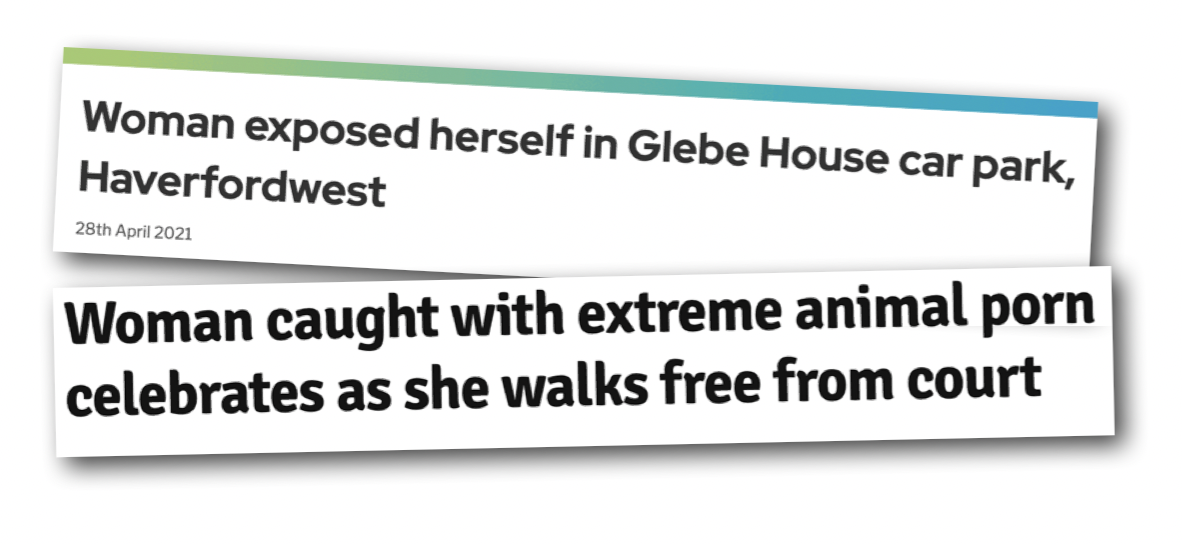 When it is reported that a woman has raped somebody, sexually assaulted somebody, exposed herself, or been found with child and animal porn on her computer – it will almost always turn out to be a man. It is so incredibly rare that women do these things that such reporting makes a huge change to the public perception of women’s offences.
When it is reported that a woman has raped somebody, sexually assaulted somebody, exposed herself, or been found with child and animal porn on her computer – it will almost always turn out to be a man. It is so incredibly rare that women do these things that such reporting makes a huge change to the public perception of women’s offences.
Anyone glancing over the headlines will be furnished with a lie. A woman did not take those photos; did not abuse those children. It is also an insult to the victims, who no doubt are very aware of the sex of the person who abused them.
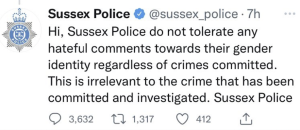 The clownshow better known as Sussex Police had a stern reprimand for those on Twitter who objected to Dixon being referred to as a woman on their website and in press reports. Leaping bravely to the paedophile’s defence, they tweeted more than once:
The clownshow better known as Sussex Police had a stern reprimand for those on Twitter who objected to Dixon being referred to as a woman on their website and in press reports. Leaping bravely to the paedophile’s defence, they tweeted more than once:
“Hi, Sussex Police do not tolerate any hateful comments towards their gender identity regardless of crimes committed. This is irrelevant to the crime that has been committed and investigated. Sussex Police”
The tweets were later deleted.
So while one might think that the arrival of the fragrant Sally Ann on the scene would have spurred people into action, we had far fewer people attend this protest than the one earlier in the year. Which leads me to wonder: has the public become jaded by all this already? Perhaps people beleive things have changed for the better since the protest in February this year? Or are we now just accepting that the placement of men in women’s prisons is ‘unfortunate but necessary’?
Have we made any steps in the right direction politically? So many questions! I asked Kate for her opinion.
“There have been 2 ministerial statements,” she told me. “The first was issued by Dominic Raab in August, after the Tory leadership contest had started. The statement said that some groups of male offenders would need ministerial sign off before an allocation to the female estate would be approved. Rishi Sunak immediately endorsed the policy stating that his government would commit to it.
Then Brandon Lewis said that male sexual offenders would not be housed in the female estate and more use would be made of separate specialist units. Now Raab is back and we assume there will be a variation of the ministerial sign off but we will need to see how it pans out. MoJ policy is still under review: I expect we willl see the release of the new version at the beginning of next year.”
Kate is cautiously optimistic that there may be a shift for the better in policy.
In October, Lewis told Conservative party delegates:
“It cannot be right that transgender prisoners, when convicted of serious sexual offences or those who have not had reassignment surgery, are housed in a general women’s estate. This will end – we have a duty of care to all those behind bars. One case of a sex attack or an inappropriate relationship formed with a female prisoner by a transgender inmate is one too many and we’ve had too many in recent years.’
Of course, it is possible to take from this that a man who has had his penis removed and who has committed a minor sexual offence will still be housed in the female estate. This is stuill unacceptable: no male prisoner should be housedf in the female estate because it is the female estate. My position- which I know is not shared by everyone – is that the GRA should be repealed and no man should be considered a woman for legal or social purposes under any circumstances. I am on the fence corncerning men working in women’s prisons. A close relative of mine taught in a women’s prison. After he died one of the women wrote in the remembrance book, “you were the first man to restore my faith in men”. Another wrote, “thank you for being such a gentle role model for the women at [name of prison]”. I believe there is a place for men teaching in women’s prisons but I know many who would disagree with me. What I would expect us all to be able to agree on is that there is no place for convicted rapists in women’s prisons.
But I digress again. Where were we? I was grabbing a quick coffee before the protest began, golden leaves shot through with autumn sunshine falling on the cold stone pavement, yada yada. It really was a beautiful autumn afternoon.
Most people had arrived by 12.30pm, placards and banners were unpacked and unfurled and the chanting started. I snapped some photos on my phone.
You can see some of Colin’s photos here.
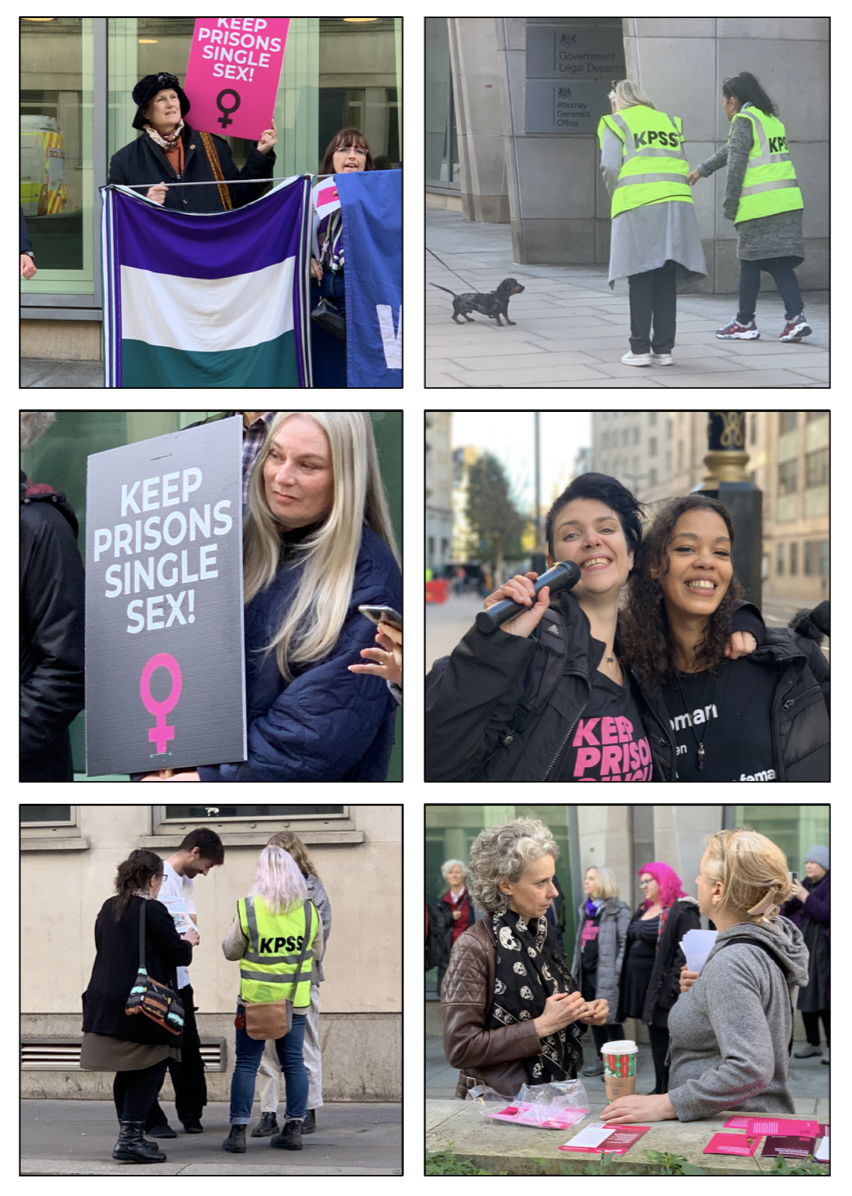
Some women positioned themselves outside St James Park tube station, handed out leaflets and started discussions with passers by. There were no counter-protestors, which is hardly surprising:.“Male paedophiles & rapists should be put in prison with women” is hardly a chant designed to capture the zeitgeist.
It was just after 12.30 so we began with some chanting to attract the attention of passers by and get us ready for the speeches.
“No males in female jails!”
“Keep prisons single sex!”
“No men in women’s prisons!”
“Women are not human shields!”
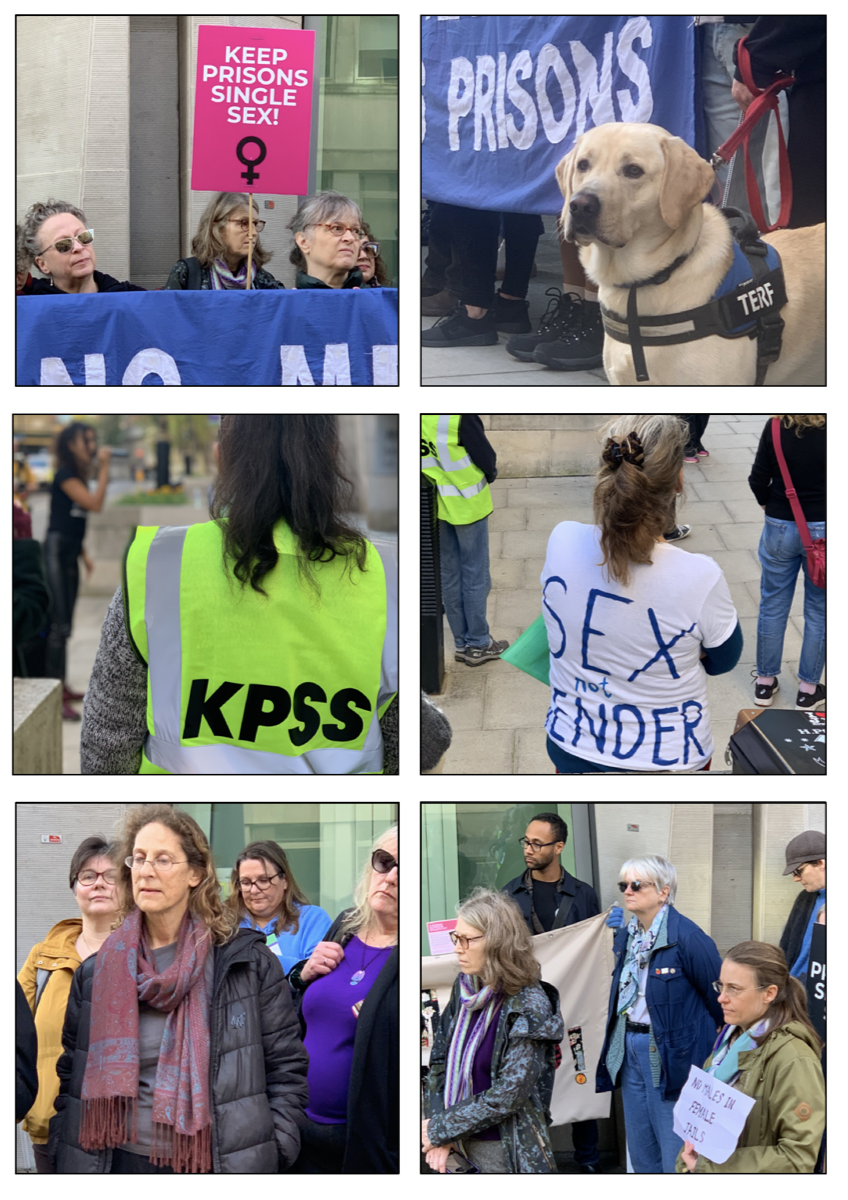
The Speakers
Kate Coleman
The first speaker was Kate Coleman of Keep Prisons Single Sex.
“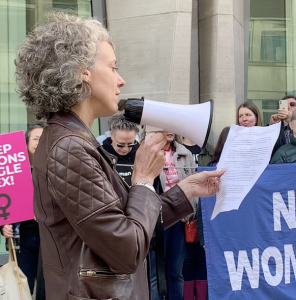 Thank you for coming along to support women in prison – a group that genuinely is amongst the most vulnerable, marginalised and at risk groups in society,” began Kate.
Thank you for coming along to support women in prison – a group that genuinely is amongst the most vulnerable, marginalised and at risk groups in society,” began Kate.
She thanked those who had attended protests past and present and spoke about the recent case of a trans-identified man in a women’s prison who got a young woman drunk on illicit homebrew before having sex with her. He is still being housed in a women’s prison.
“If risk assessment permits this, the risk assessment is not fit for purpose.”
“The Ministry of Justice claims that men – and I will call them men, because men is who they are – are only ever housed in a woman’s prison if a thorough process of risk assessment shows that it is safe to do so. At the same time, men with intact male genitalia who have been convicted of the most serious, violent, sexual offences against women and children have passed this process and been risk assessed as ‘safe’. This is a nonsense and, frankly, an obscenity.”
Kate acknowledged that she hopes things will change for the better.
“… as dire as the situation continues to be, there is movement. Ministers now agree that the current policies are not keeping women in prison safe. They agree that something must change… There is a clear desire at the highest levels for movement in the right direction. We must keep on pushing.What we do works. We know our voice is being heard. So let’s keep it up!”
Richard Garside
 “Some say the campaign to stop men being imprisoned in women’s prisons is a distraction from the real issues of prison reform, problems like self-harm, suicide and violence, problems like mothers being separated from their children; problems like appalling living conditions; problems like the failure of prisons to reform prisoners. Given these big challenges, the argument is that to focus on a very few number of men who are imprisoned in women’s prisons is a bit of a distraction, almost irrelevant.
“Some say the campaign to stop men being imprisoned in women’s prisons is a distraction from the real issues of prison reform, problems like self-harm, suicide and violence, problems like mothers being separated from their children; problems like appalling living conditions; problems like the failure of prisons to reform prisoners. Given these big challenges, the argument is that to focus on a very few number of men who are imprisoned in women’s prisons is a bit of a distraction, almost irrelevant.
Well, I think it’s true is clear from those who are here today, that there are many who think it’s highly relevant.”
Garside stressed the importance of being able to define what a woman is in order to be address the issues that affect women in prison. Currently, he said, men’s prisons are single-sex institutions and women’s prisons are mixed sex. This ‘places the claims and demands of male prisoners beyond the needs of women’s prisoners’.
Women’s prisons should be single sex, not just to give women privacy and dignity but also “… to help prevent unplanned pregnancies for example, regardless of the concensual nature of the sexual activity: to protect women from sexual violence by men, or at least to reduce the risk of sexual violence by men- because let’s remember, there are also male prison officers in women’s prisons- to give women privacy and dignity in what is a very traumatic and difficult set of institutions. To ensure that women who’ve been traumatised by male violence are not re-traumatised by being asked to share their spaces with men.”
The prison system was created by men to contain “males who are violent, unruly and disruptive. They were never designed to hold women.”
He concluded with a call for the abolition of women’s prisons altogether, which I wasn’t expecting.
“There is no need actually to imprison any woman in this country. So alongside the demand of keeping prison single sex ,we also need to be clear that we shouldn’t have women in women’s prisons either. We should close them all down.”
Rebekah Wershbale
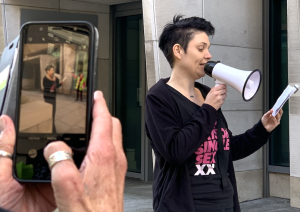 Rebekah, speaking as a woman who has experienced the prison system as an inmate, began by pointing out some differences surrounding the reasons why men and women find themeselves in prison.
Rebekah, speaking as a woman who has experienced the prison system as an inmate, began by pointing out some differences surrounding the reasons why men and women find themeselves in prison.
Women represent just 4-5% of the entire prison population in the UK and women are imprisoned overwhelmingly for non violent offences.
“Over half of all prosecutions are for motoring offences. TV licence evasion and
shoplifting are the 2nd and 3rd most common crimes women serve custodial sentences for. Women in prison are there because they’ve committed crimes as a result of poverty,
destitution and desperation. We steal to feed and clothe our children. We push TV licensing down huge lists of priorities and we are penalised incredibly harshly for it.
Women are not drawn to crime – we represent just under 15% of all arrests… the demographic of female prisoners paints a woeful picture of marginalised, vulnerable women that have been pushed past their limits. I know this because I was one of those women, and called others friends while I was housed with them.”
95% of violent crime is committed by men and 40% of their convictions for violence are for crimes against women. Rebekah spoke of the women she encountered in prison who had been convicted of murder.
” I can’t speak for every murderer in the prison system of course but every last one of those women – who again, I counted as my friends – were there because they’d killed their male abusers, after months and years of rape, torment and violence. Every. Last. One.”
Almost half of men’s violent crimes against women are sex offences.
“18% of men in prison in the UK are there for serious sex offences… of this 18% of rapists and paedophiles, guess what? Half of them say they’re women, and they’re routinely moved to the women’s estate, penis and all.”
Assaults against women by men placed in the female estate can and have happened, so why do men continue to be placed in women’s prisons by policy makers who are more scared of being branded ‘transphobic’ than perotecting the women in their care?
“WHY should a woman serving a short sentence for failure to pay parking tickets have to
accept intimidation and terror as part of her already disproportionate punishment? WHY should an 18 year old girl on remand for shoplifting expect the potential for rape and assault by a man in a wig during her stint?” WHY do these questions even need to be asked?”
Asserting again that ‘men and women are different’ Rebekah conclude that women ‘are having our reputations dragged through the mire by the men who would wear our skin. These are not our crimes, and our prisons are no place for these revolting, duplicitous men. We will not stop shouting about this until every last one of these deviants is identified and returned back to the male estate where they belong.”
Joan Smith
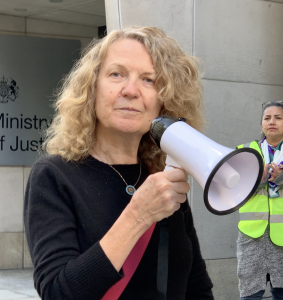 Joan Smith has been writing about violence against women since 1989 and finds it hard to believe that even now our criminal justice system is failing women ‘across the board’, refering to the fact that just 1.5% of rapes end in a conviction.
Joan Smith has been writing about violence against women since 1989 and finds it hard to believe that even now our criminal justice system is failing women ‘across the board’, refering to the fact that just 1.5% of rapes end in a conviction.
“We imprison women who are themselves victims of that system,” she observed, noting that “most women in prison are victims of repeated domestic and sexual violence. Over half of them have head injuries, they have traumatic brain injuries and we lock them up. And then we allow men into those prisons: the very people that they’re afraid of- the people who have abused them.”
Joan criticised the ‘be kind’ message which is directed almost entirely at women and girls, asking rhetorically, “What about women? What about being kind to women? What about being kind to women who have been raped? What about being kind to women who’ve suffered years and years of sexual and domestic abuse, and then they’re locked up and they’re told that they have to share with these violent men?”
What if, she speculates, Sarah Everard’s murderer, ex-police officer Wayne Cousins, suddenly identified as a woman and didn’t feel ‘safe’ in the male estate? Would he be put in a women’s jail?
Joan concluded, “I do think that this is part of a wider misogyny and that we have to fight both for the rights of women in prison and for the rights of women who are themselves victims of crime and they are often the same people.”
Testimonies from female prisoners
Finally, Maggie, a prison volunteer, read us out some testimonies from prisoners, women who had been affected by the placing of men in women’s prisons.


You can view Stephen Knight’s video of the speeches here, on YouTube.
Jen Critical
After the speeches, Jen led everyone in singing ‘Something Inside So Strong’ and “I am Woman, Hear Me Roar’ before treating us to a pre-release rendition of her new song, ‘Don’t Call Me Cis’. Many of the protestors joined in with the first songs, singing and swaying to the music.

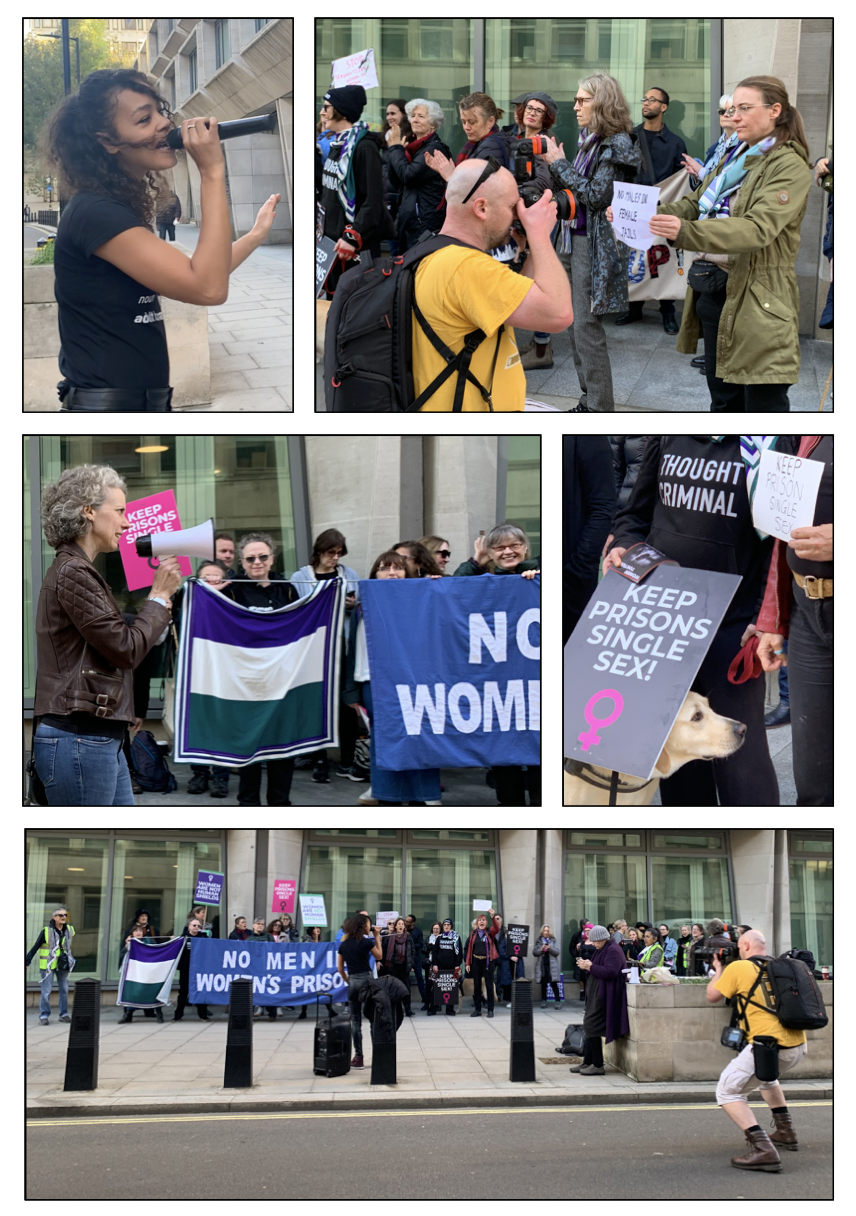
After the songs, we wound things up. Some went to sit in nearby St James Park, others retired to a nearby pub, some headed home to walk dogs, go to work or collect children. As we pacxked up, I spoke to some of the women and asked their reasons for coming here today.
“… I couldn’t believe that society was that cruel that they would put rapists and sex offenders in with women. I’ve listened to women speak about being in prison and heard them talk about the vile things shouted at them by AGPS in their wing. I don’t think women should encounter this. If you’ve committed a crime, punishment is what happens, but you should have dignity, you should be safe and you shouldn’t feel threat in your environment. I feel really stringly about this.”
“The situation in women’s prisons is what really got me involved in all this in the first place. I don’t see how anyone with an ounce of compassion can think it’s okay for a woman prisoner- who is likely to have already been sexually abused- to be locked up with a rapist.”
“I think I’m actually quoting Kate (Coleman) if I say these are invisible women, you know we can physically see the harm that is being caused by the trans movement towards women in general, but women in jail you can’t, so I think it’s even more important to support them more than anything.”
“I’m here because women in prison are some of the most vulnerable in our society and what is happening is an outrageous injustice which everyone should be protesting.”
“When I was six I learned that men can do what they want to you and if you say no it doesn’t matter. And now I’m thirty one I refuse to stand by and let other people get raped and be told ‘deal with it’. Men shouldn’t be in women’s prisons.”
“I’ve been handing out leaflets and pretty much 99% of people I’ve handed a leaflet to have also agreed that it’s unbelievable that men are put in female prisons, whether they identify- I don’t know – as a brush? – or a woman. Many of these men are in prison because of sexual assault, rape or paedophilia… these women should not be used as human shields to indulge men’s fetishes.”
“Some of these women have had awful lives and men have done terrible things to them. And now men come into their prisons, dressing up like being a woman is some sort of game they can play, for fun and kicks. This is like some kind of sick joke, you could almost make a Black Mirror episode out of it.”
“We are supposedly a humane society so surely we have a duty to protect women in prison. What is our government thinking, I mean really what is it thinking, to be putting rapists and paedophiles in prison with women? We know they know what is happening, we know they know women are being assaulted and intimidated by these men, it’s been in all the papers so why aren’t they stopping it? Why haven’t they stopped it already?”
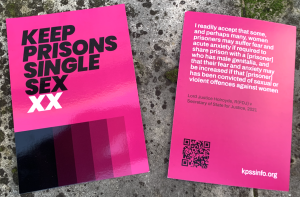

Sounds like it was a great protest I was at the protest at Downsview and Jen came to sing her songs which were really inspiring. It is about time the lustice Minister takes action now to stop men in women’s prisons totally